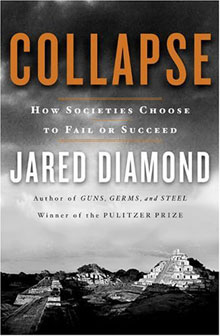Book Notes
 Jared Diamond, Collapse; How Societies Choose to Fail or Succeed (New York: Viking, 2005), 576pp.
Jared Diamond, Collapse; How Societies Choose to Fail or Succeed (New York: Viking, 2005), 576pp.
Crawling through the tunnels of the pyramids at Giza, sitting in a coliseum in Turkey built 2,000 years ago, or visiting churches hewn out of rock 800 years ago in the remote desert of Ethiopia, I have wondered: where in the world did the people of these advanced civilizations go? How did they vanish?! In his Pulitzer Prize-winning book Guns, Germs and Steel (1999) Diamond focused on how the west came to dominate the rest of the globe economically, politically, militarily and even culturally; in the present tome he looks at how societies fail. At first he thought his book would focus exclusively upon environmental factors in social collapse (he delineates twelve environmental factors like deforestation, water management, over hunting, introduction of non-native species, etc.), but when he discovered this was too simplistic he added four other contributing factors: climate change, hostile neighbors, declining support from friendly neighbors (eg, trade partners), and human responses to their social problems. He repeatedly takes to task greedy, myopic, power-mongering political rulers.
Diamond applies this fivefold grid to a series of roughly twenty geographic case studies — large and small, ancient and modern, peripheral and advanced, successes and failures. He claims to write from a middle-of-the-road position (p. 17), and he rejects the doom-and-gloom moniker. He insists he is no fear-monger. But a clear subtext to this book is how our modern world might parallel aspects of the catastrophic social collapses he identifies. One irritating habit he has is to conclude chapters with a moralistic, pessimistic insinuation: "If 'x' happened then and there, what might we expect here-and-now?" In the final three chapters he turns to practical lessons we might draw from his case studies. He hazards why societies make disastrous decisions. A chapter on big business and the environment concludes that since businesses have a fiduciary obligation to shareholders to maximize profits, it is up to the public, not the businesses, to hold them accountable (p. 484). He rightly notes that this boils down to a conflict of cultural values. In the end, he describes himself as guardedly optimistic about our modern world's prospects (pp. 499, 521).
The biggest problem with Diamond's method is that, because of the nature of his study, he is necessarily long on possible theories for social collapse and short on hard data. In some instances we have a modicum of direct but fragmentary written evidence left to us by past societies, but for the most part tentative conclusions must be drawn from indirect and incomplete archaeological evidence. So, throughout his book he admits that some of his theories are much disputed, highly controversial, matters of vigorous disagreement, lacking firm proof, and, ultimately, matters of inference, conjecture, guesswork, and extrapolation. As in so much science, especially social science, description ("these societies collapsed") is far easier than explanation ("but why?"). In addition, the nomenclature of what, technically, constitutes a "success" or "collapse" is debatable.
Not all societies collapse. I especially appreciated Diamond's inclusion of unlikely candidates that have succeeded. Little Tonga (288 square miles) has percolated along for 3,200 years (p. 277). People in New Guinea have led self-sustaining lives for 46,000 years (p. 280). Iceland has one of the highest per capita incomes in the world today. Still, it is frightening to admit that the world today is on a decidedly non-sustainable course. Most of the majority world that aspires to live like the minority, first world cannot and never will live like us. If China alone, to take just one example, succeeded in matching first-world consumption rates, it would double the impact on the world's resources and environment (p. 373). So, one can quibble with the grand explanations about social collapse; but that societies have collapsed, partly as a result of the choices they made, is a sobering reminder that planet earth today is a fragile, finite resource dependent upon human values and decisions.


